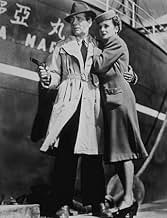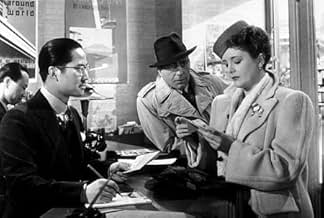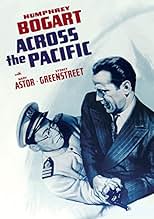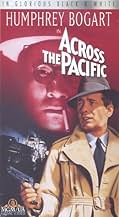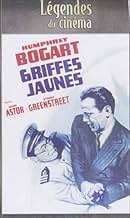VALUTAZIONE IMDb
6,8/10
5628
LA TUA VALUTAZIONE
Aggiungi una trama nella tua linguaIn December 1941, ex-army captain Rick Leland boards a Japanese ship heading to Asia via the Panama Canal where his Japanese hosts show interest in the American defense plans for the canal z... Leggi tuttoIn December 1941, ex-army captain Rick Leland boards a Japanese ship heading to Asia via the Panama Canal where his Japanese hosts show interest in the American defense plans for the canal zone.In December 1941, ex-army captain Rick Leland boards a Japanese ship heading to Asia via the Panama Canal where his Japanese hosts show interest in the American defense plans for the canal zone.
- Regia
- Sceneggiatura
- Star
- Premi
- 1 vittoria e 1 candidatura in totale
Victor Sen Yung
- Joe Totsuiko
- (as Sen Young)
Lee Tong Foo
- Sam Wing On
- (as Lee Tung Foo)
Recensioni in evidenza
This film is okay -- watchable and even interesting -- but one can't help comparing it to "The Maltese Falcon" which appeared the previous year. Same principle actors -- Bogart, Mary Astor, Sidney Greenstreet -- no Peter Lorre fondling the handle of his cane, alas, and no gunsel -- and, for the most part, the same Director, John Huston. Huston was called up for Signal Corps duty halfway through filming and as a gag shot the scenes up to the point at which Bogart was strapped helplessly into a chair and surrounded by armed guards, a situation seemingly without the possibility of escape. Then Huston cheerfully said goodbye and walked off the set, leaving his replacement, Vincent Sherman, to try to figure out how to get Bogart free.
It may be unfair to compare "Across the Pacific" to a lucky shot like "The Maltese Falcon," but this film invites the comparison. Not just the same performers but similar lines -- "You're good, Angel, very, very good." But in Falcon the actors fit their fictional characters like enzymes accommodating themselves to a substrate. Here they are just actors playing familiar roles: the obese villain, the officer who's dishonorable discharge is faked so he can go undercover (Gary Cooper could have done as well, and in fact DID in a later movie), the innocent woman made to look bad because the enemy has imprisoned her dissolute father. The Japanese are all plain-vanilla bad guys, even the familiar young one who makes amusing wisecracks in American slang. And all the Japanese have real names like Tong, Chan, Loo, Fong, and Ahn. (To be fair, the last one is Korean, not Chinese.)
If the characters are not nearly as much fun to watch as in "The Maltese Falcon," the plot is no more than a simple war-time mystery involving secret information that the Japanese want to use to start the war by torpedoing the locks of the Panama Canal. Actually, the Japanese did develop such plans later in the war. They intended to deliver a handful of torpedo planes to the vicinity of the Canal in huge submarines, which were available. The planes were not, and the plans folded when the war ended.
In the movie, the characters move from New York to Canada, then board a Japanese steamer, back to New York, then to Panama, where they disembark. They travel from the Atlantic side of the canal to the Pacific -- but they never make it across the Pacific.
It may be unfair to compare "Across the Pacific" to a lucky shot like "The Maltese Falcon," but this film invites the comparison. Not just the same performers but similar lines -- "You're good, Angel, very, very good." But in Falcon the actors fit their fictional characters like enzymes accommodating themselves to a substrate. Here they are just actors playing familiar roles: the obese villain, the officer who's dishonorable discharge is faked so he can go undercover (Gary Cooper could have done as well, and in fact DID in a later movie), the innocent woman made to look bad because the enemy has imprisoned her dissolute father. The Japanese are all plain-vanilla bad guys, even the familiar young one who makes amusing wisecracks in American slang. And all the Japanese have real names like Tong, Chan, Loo, Fong, and Ahn. (To be fair, the last one is Korean, not Chinese.)
If the characters are not nearly as much fun to watch as in "The Maltese Falcon," the plot is no more than a simple war-time mystery involving secret information that the Japanese want to use to start the war by torpedoing the locks of the Panama Canal. Actually, the Japanese did develop such plans later in the war. They intended to deliver a handful of torpedo planes to the vicinity of the Canal in huge submarines, which were available. The planes were not, and the plans folded when the war ended.
In the movie, the characters move from New York to Canada, then board a Japanese steamer, back to New York, then to Panama, where they disembark. They travel from the Atlantic side of the canal to the Pacific -- but they never make it across the Pacific.
WWII intrigue is served up in the days leading up to the bombing on Pearl Harbor. However, in an apparent late decision by the writers to not mention Pearl Harbor, the bombing target becomes Panama so history can be ignored. Bogart is cool as always as an artillery officer. He is reunited with his co-stars, Astor and Greenstreet, both in fine form, and director Huston from "The Maltese Falcon." Unfortunately, the script is rather convoluted and rambling, seemingly written in a rush to cash in on the success of the earlier film. The dialog is crisp and witty. If only the plot had been better, this could have been a classic.
Richard Macaulay had to do some fast rewrites on this John Huston-directed picture, based upon a magazine serial by Robert Carson. When dishonorably discharged Army Officer Humphrey Bogart is revealed to be a spy staking out a powerful Japanese sympathizer aboard a vessel to the Orient, the portly commander was originally supposed to be supervising the bombing of Pearl Harbor. When that occurred in real-life while the picture was in production, Macaulay hurriedly switched the locale to the Panama Canal (making the film's title irrelevant). However, even if the story structure is patchy--and Mary Astor's role as a plantation owner's daughter ultimately doesn't make much sense--"Across the Pacific" has a dryly joshing quality about it, and the end results are pleasant if unremarkable. Bogart (playing 'Rick', sometimes 'Ricky') is in jovial spirits throughout, especially when comparing gun sizes with Sydney Greenstreet (never better) or fingering Astor's back after she's acquired a sunburn; his blithe, easy performance makes the film enjoyable. Astor (ostensibly the love-interest) doesn't pour on the charm in her scenes with Bogie; she plays it rather big-sisterly with him, a seen-it-all kind of gal, and this works extremely well. The finale is a sign of the times--American fighter planes fill the skies--but even this corny touch works a little magic, despite the film's misshapen quality and sluggish beginning. **1/2 from ****
"Across the Pacific" is a fairly well done spy movie that takes place in the last days before America's entry into World War II. Rick Leland (Humphrey Bogart) is cashiered from the U.S. Army for stealing funds. The events that follow involve a love interest (Mary Astor) and an enemy agent (Sydney Greenstreet) and a trip on a passenger ship from New York to the Panama Canal. Humphrey Bogart as an American spy is convincing in a role that might have been played by Sean Connery 20 years later.
The subplot of a Japanese plot to torpedo the Panama Canal and put it out of action was a case of truth being stranger than fiction with the recent revelation of Japanese submarines which carried planes designed to knock the canal out, but which were never used. "Across the Pacific" has humor, action and romance and is one of Bogart's lesser known but very good movies.
The subplot of a Japanese plot to torpedo the Panama Canal and put it out of action was a case of truth being stranger than fiction with the recent revelation of Japanese submarines which carried planes designed to knock the canal out, but which were never used. "Across the Pacific" has humor, action and romance and is one of Bogart's lesser known but very good movies.
There are films that are so connected to their times, when taken out of context there's no rhyme, no reason for portrayals, but factor in the great betrayals, lets you accept the extremes, of paradigms. As Rick Leland is disgraced and then ejected, from a role that he would like to have perfected, leaves him in a tricky place, after losing all his face, and he's become quite disengaged and disaffected. On a boat he gets to meet curious souls, who have ambitions to dispose and take controls, as the layers are peeled back, looks like there might be an attack, by the folks who like to eat food out of bowls.
Of its time.
Of its time.
Lo sapevi?
- QuizDirector Vincent Sherman met with John Huston just before Huston left the project to join the United States Army Signal Corps to shoot documentaries for the war effort.
The two directors conferred just before they were about to shoot the scene in which Leland is trapped in the movie theatre and three assassins are trying to kill him.
"How does he get out?" Sherman asked. Huston replied, "That's your problem! I'm off to the war!"
John Huston then went off to join the war effort before the film was finished, taking the film script with him, explaining "Bogie will know how to get out." The studio's solution to the problem was to discard Huston's footage of the impossible dilemma and write a new scenario. Vincent Sherman directed the final scenes.
- BlooperThe background for the opening titles is a map of the Panama Canal. The orientation of the map and the compass is correct, but the labeling of the map is incorrect. In fact, the Atlantic end of the canal and the city of Colon are at the upper left (Northwest), and the Pacific end of the canal and Panama City are at the lower right (Southeast). The map is correctly labeled behind the closing credits.
- Citazioni
Rick Leland: [comparing his gun to Dr. Lorenz's, which he points at him] Remember: mine is bigger than yours!
- Curiosità sui creditiOpening Card:
Governor's Island
New York
- Versioni alternativeAlso available in a computer colorized version.
- ConnessioniFeatured in Frances Farmer Presents: Across the Pacific (1959)
I più visti
Accedi per valutare e creare un elenco di titoli salvati per ottenere consigli personalizzati
- How long is Across the Pacific?Powered by Alexa
Dettagli
- Data di uscita
- Paese di origine
- Lingue
- Celebre anche come
- Across the Pacific
- Luoghi delle riprese
- Azienda produttrice
- Vedi altri crediti dell’azienda su IMDbPro
- Tempo di esecuzione1 ora 37 minuti
- Colore
- Proporzioni
- 1.37 : 1
Contribuisci a questa pagina
Suggerisci una modifica o aggiungi i contenuti mancanti


